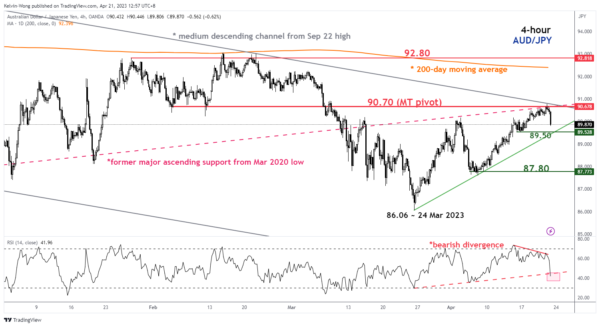- Japan sticky inflation (excluding fresh food & energy) continued to increase for 10 consecutive months.
- Flash manufacturing PMI for April has shown signs of bottoming out from contraction.
- AUD/JPY reversed from key medium-term resistance at 90.70.
Market participants in the financial markets will turn their focus to the Bank of Japan’s monetary policy decision outcome next week on Friday, 28 April under the helm of a new Governor, Kazuo Ueda.
Why is it important?
During a decade-long tenure of the prior Governor Haruhiko Kuroda, BoJ has changed the course of the financial markets by the unleash of close to US$3.4 trillion worth of liquidity into the global financial system under the ambitious expansionary “Abenomics” program to combat the risk of global deflation triggered by the aftermath of the Great Financial Crisis of 2008.
Right now, the world is facing a sticky heightened inflationary situation where developed nations’ central bankers have started to ramp up interest rates hike and reverse their respective Quantitative Easing programs since early 2022. The remaining laggard among them is BoJ which still maintained a negative policy interest rate at -0.10%.
Hence, a slight change in monetary policy from ultra-easy to normalization under new BoJ Governor Ueda is likely to see significant funds flow reversal back into Japan as Japanese investors have accumulated a mountain of offshore investments that amounted to more than two-thirds of Japan’s GDP due to the” Yield Curve Control” (YCC) program enacted in 2016 to put a cap on the yield of the 10-year Japanese Government Bond (JGB).
If such a scenario happens, it can send shockwaves and a dominoes effect in the global financial markets where fixed income yields in the US and Europe may spike up and an increased risk of capital flight out of emerging markets.
Maintaining dovish monetary guidance over local economic realities
Since the last “monetary policy shock teaser” from BoJ in December 2022 where it widened the band of its YCC program to allow the yield of the 10-year JGB to move by 50 basis points from 25 basis points on either side of the 0% target, and market participants took such a move as a precursor to an end of ultra-easy monetary policy in Japan and started to increase bullish and bearish bets on JPY and JGB respectively.
Since taking over the helm at BoJ in early April, Ueda has started to tone down the speed of BoJ’s monetary policy normalization and gave clear guidance during the Spring IMF meeting that BoJ is likely to maintain its ultra-low interest rate at this juncture; indicating no rush to implement a policy change.
However, the latest local economic data do not seem to support the continuation of ultra-easy monetary policy for Japan. Even though the headline inflation rate for March dipped to 3.2% year-on-year from February’s print of 3.3%, 2 consecutive months of growth declined from January’s 4.3% but implied sticky inflation as measured by excluding fresh food and energy (core core inflation rate) continued to climb to 3.8% year-on-year in March from 3.5% in February, ten consecutive months of expansion to hover close to a four-decade high.
In addition, manufacturing activities have started to show signs of bottoming out from contraction; the April flash Jibun Bank Manufacturing PMI increased to 49.5 from a final reading of 49.2 in March, indicating its highest reading since October 2022.
Hence, with inflation staying above BoJ’s target of 2% for a year and manufacturing activities have started to improve, BoJ may start to give an implicit heads-up on laying the groundwork for the normalization of its ultra-easing policy in the coming meeting next Friday with hints coming from the latest inflationary and growth data projections in its economic quarterly outlook report to be released on the same day as well as Ueda’s press conference.
AUD/JPY Technical Analysis – Retreated from key medium-term resistance ahead of BoJ
Source: TradingView as of 20 Apr 2023 (click to enlarge chart)
The AUD/JPY cross rate has staged a negative reversal from its 90.70 key medium-term pivotal resistance today with several bearish elements. Hence, the latest price actions suggest there is an increased risk that the recent 470 pips rally from its 24 March 2023 low of 86.06 is likely to be considered as a minor corrective rebound (dead cat bounce) within a medium-term downtrend phase in place since September 2022 high of 98.69.
In addition, short-term downside momentum has resurfaced as indicated by the 4-hour RSI oscillator where it is now breaking below key corresponding support at the 44% level after a prior bearish divergence seen at its overbought region.
A break below 89.50 immediate support may expose the next support at 87.80. However, a clearance with a 4-hour close above 90.70 negates the bearish tone for a squeeze up towards the next resistance at 92.80 (swing high areas of 26 January/15/22 February 2022 & close to the key 200-day moving average).













